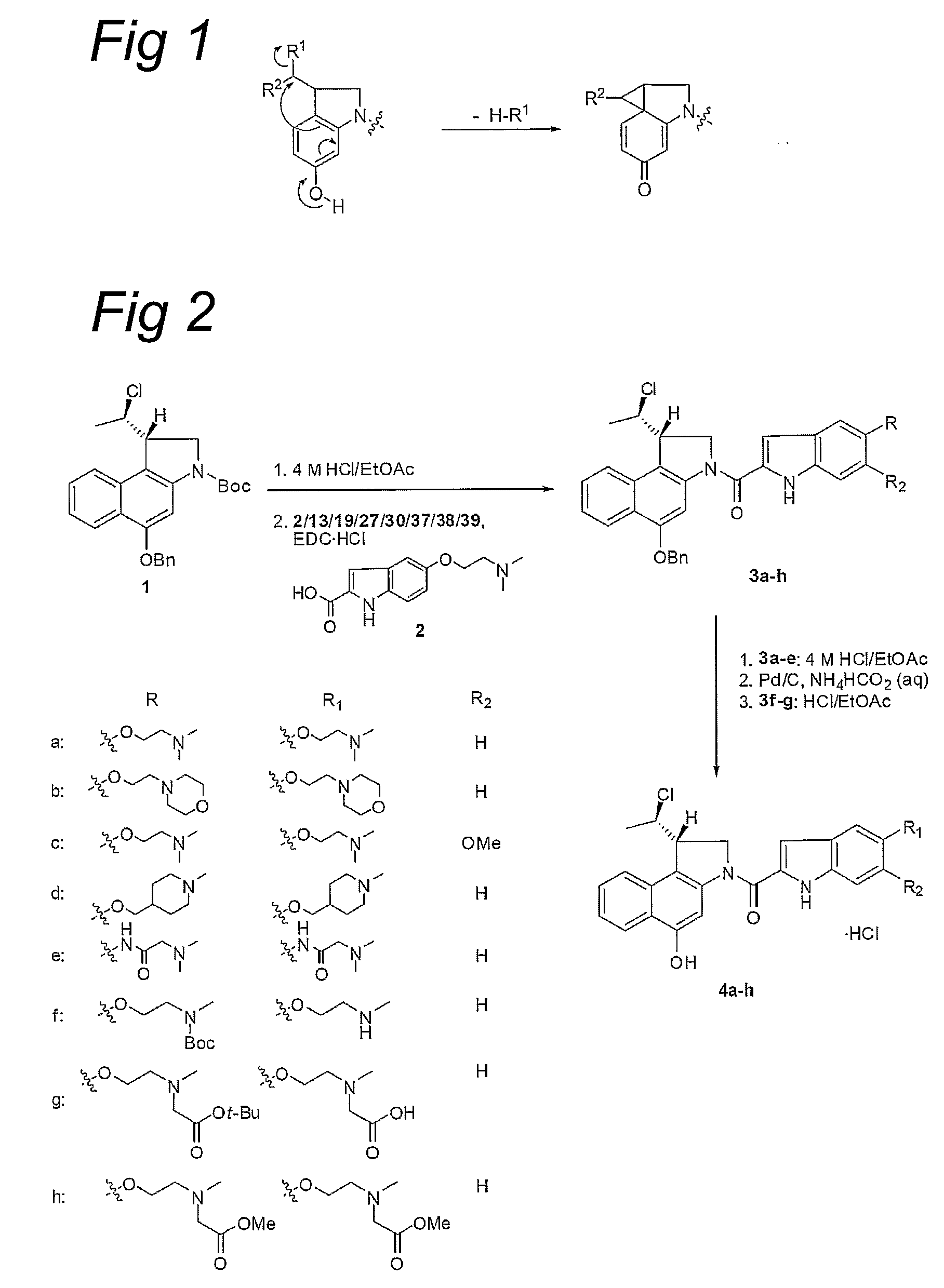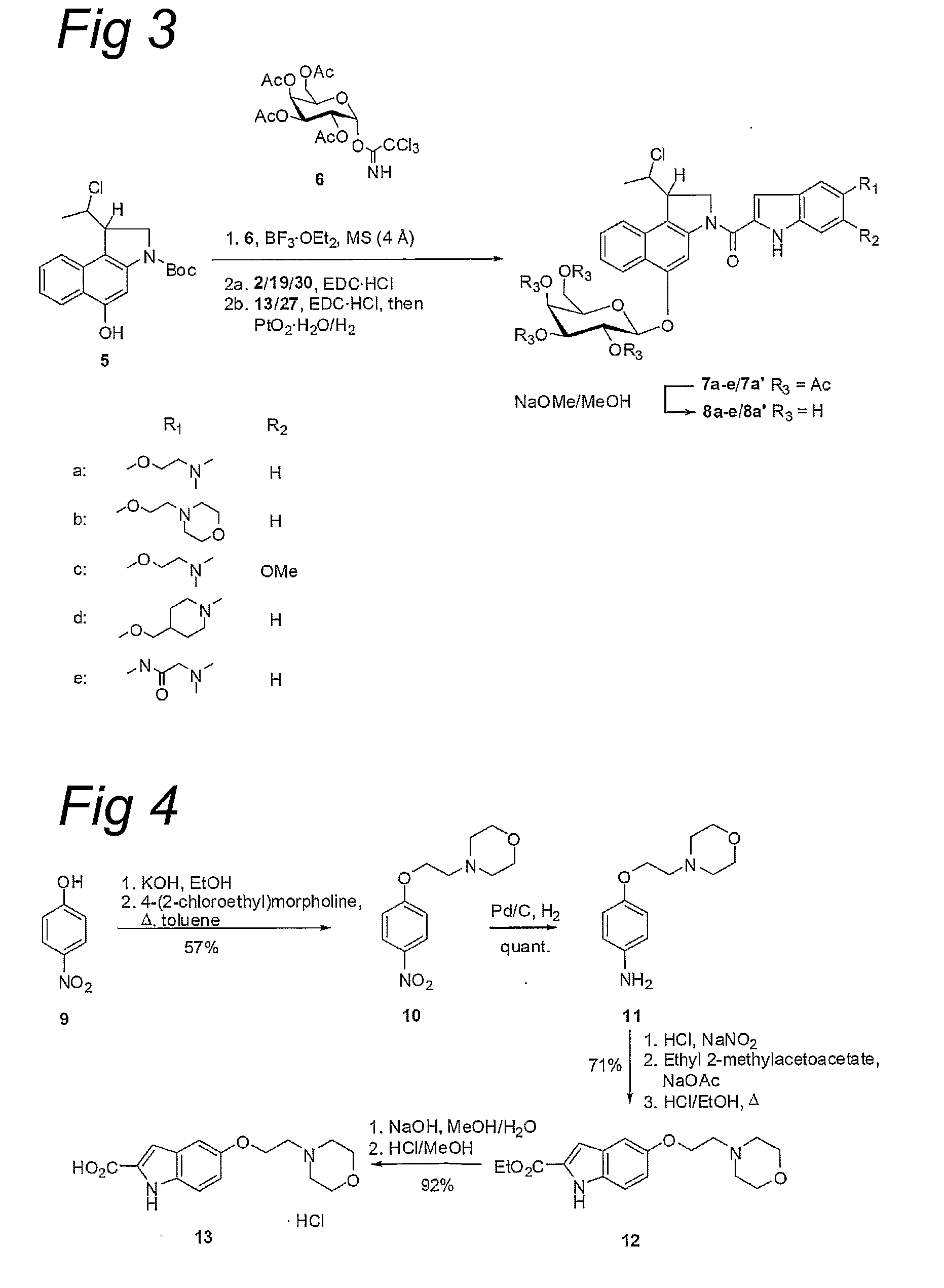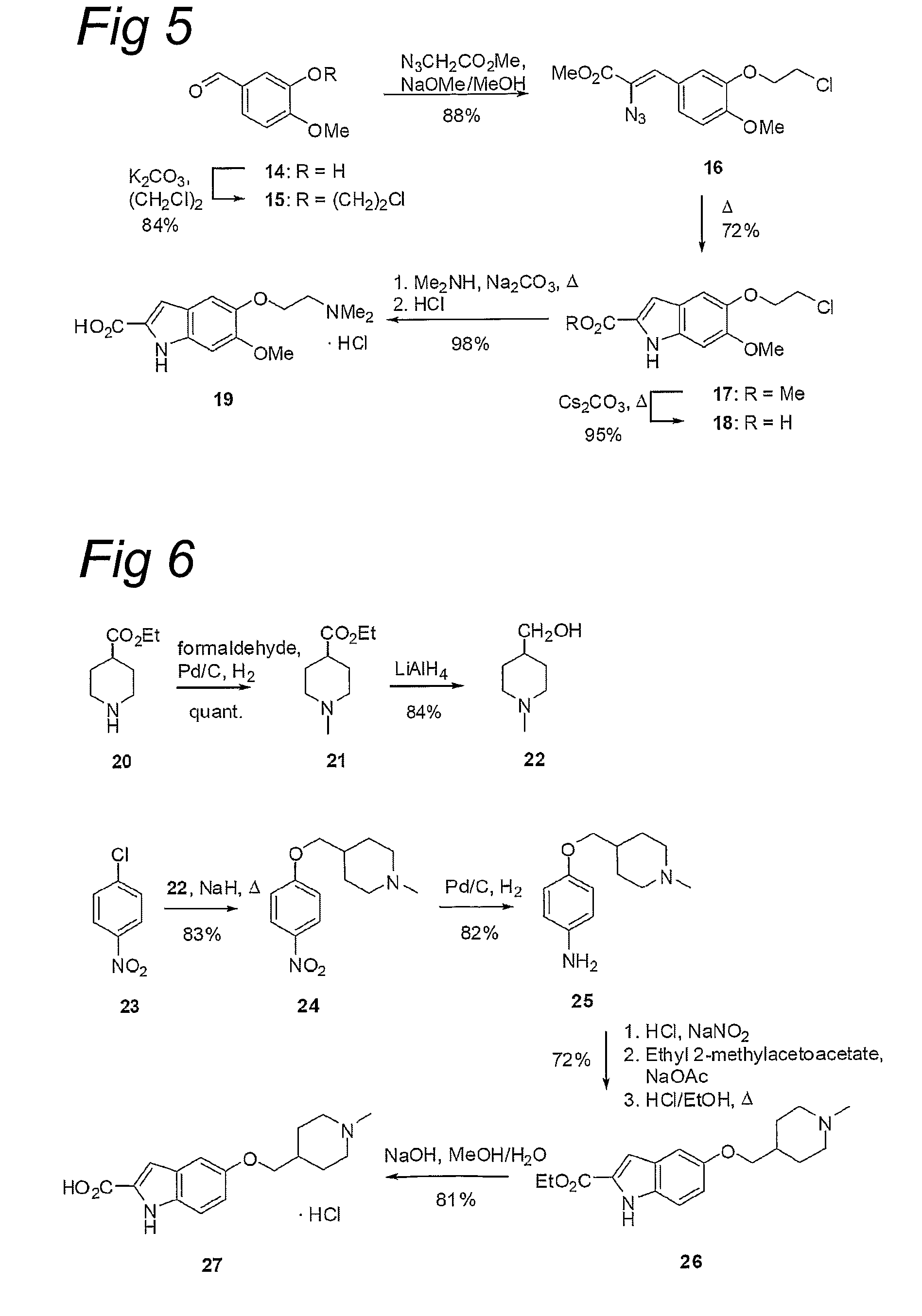Water-Soluble CC-1065 Analogs and Their Conjugates
- Summary
- Abstract
- Description
- Claims
- Application Information
AI Technical Summary
Benefits of technology
Problems solved by technology
Method used
Image
Examples
example 1
[0623]rac-{(1,10)-anti-5-Benzyloxy-3-[(5-(2-(N,N-dimethylamino)ethoxy)-indol-2-yl)carbonyl]-1-(10-chloroethyl)-1,2-dihydro-3H-benz[e]indole} (rac-3a): Racemic 1 (100 mg, 228 μmol) was suspended in 4 M HCl / EtOAc and stirred at room temperature for 3 h. The reaction mixture was concentrated and dried in vacuo for 1 h. The residue was dissolved in DMF (10 mL). The solution was cooled to 0° C. and EDC.HCl (131 mg, 684 μmol, 3.0 equiv.) and 2 (82.0 mg, 288 μmol, 1.3 equiv.) were added. The reaction mixture was stirred at room temperature for 2 d, diluted with ethyl acetate (50 mL), water (50 mL), and saturated aqueous NaHCO3, and extracted with ethyl acetate (3×100 mL). The combined organic layers were washed with brine (4×100 mL), dried over MgSO4, filtered, and concentrated in vacuo. Column chromatography (CH2Cl2 / MeOH=10:1) gave racemic 3 as a pale brown solid (81 mg, 143 μmol, 63%). 1H-NMR (300 MHz, CDCl3): δ=1.65 (d, J=6.8 Hz, 3H, 11-CH3), 2.37 (s, 6H, NMe2), 2.78 (t, J=5.8 Hz, 2H, 2...
example 2
[0624]rac-{(1,10)-anti-1-(10-Chloroethyl)-5-hydroxy-3-[(5-(2-(N,N-dimethylamino)ethoxy)indol-2-yl)carbonyl]-1,2-dihydro-3H-benz[e]indole-hydrochloride} (rac-4a): Racemic 3a (200 mg, 352 μmol) was dissolved 4 M HCl / ethyl acetate (15 mL) and stirred for 2 h at room temperature. The solution was concentrated. The residue was dried in vacuo for 1 h and then suspended in THF (15 mL). 10% Palladium on activated carbon (75 mg) and ammonium formate (25% aqueous solution, 0.75 mL) were then added at room temperature. The reaction mixture was stirred for 2 h at 40° C. and filtered over Celite, which was thoroughly rinsed with methanol (200 mL). The filtrate was concentrated in vacuo and the residue was purified by column chromatography (CH2Cl2 / MeOH=5:1, 1% conc. HCl) to give rac-4a as a green-yellow powder (146 mg, 284 μmol, 81%). 1H-NMR (300 MHz, DMSO-d6): δ=1.62 (d, J=6.7 Hz, 3H, 11-CH3), 2.84 (s, 6H, NMe2), 3.51 (t, J=5.0 Hz, 2H, 2″-H2), 4.16 (mc, 1H, 1-H), 4.39 (t, J=5.0 Hz, 2H, 1″-H2), 4...
example 3
[0625][(1,10)-anti-1-(10-Chloroethyl)-3-[(5-(2-(N,N-dimethylamino)ethoxy)indol-2-yl)carbonyl]-1,2-dihydro-3H-benz[e]indol-5-yl]-2,3,4,6-tetra-O-acetyl-β-D-gatactopyranoside ((+)-7a / (−)-7a′): A solution of rac-5 (381 mg, 1.10 mmol) in dry CH2Cl2 (50 mL) and molecular sieves 4 Å (1.5 g) was stirred for 30 min at room temperature. After addition of O-(2,3,4,6-tetra-O-acetyl-α-D-galactopyranosyl)-trichloracetimidate (6) (564 mg, 1.15 mmol, 1.05 equiv.), the mixture was cooled to −10° C. and a solution of BF3.OEt2 (69.0 μL, 548 μmol, 0.5 equiv.) in dry CH2Cl2 (5.5 mL) was slowly added. After 3 h at −10° C., additional BF3.OEt2 (0.42 mL, 3.29 mmol, 3.0 equiv.) in dry CH2Cl2 (5.0 mL) was added and the mixture was warmed to room temperature. After 5 h, the solution was separated from the molecular sieves, the molecular sieves were thoroughly rinsed with CH2Cl2 (2×20 mL), and the combined organics were concentrated in vacuo. The residue was dried in vacuo for 1 h and then dissolved in dry DM...
PUM
| Property | Measurement | Unit |
|---|---|---|
| Electrical conductance | aaaaa | aaaaa |
| Electrical conductance | aaaaa | aaaaa |
| Solubility (mass) | aaaaa | aaaaa |
Abstract
Description
Claims
Application Information
 Login to View More
Login to View More - R&D
- Intellectual Property
- Life Sciences
- Materials
- Tech Scout
- Unparalleled Data Quality
- Higher Quality Content
- 60% Fewer Hallucinations
Browse by: Latest US Patents, China's latest patents, Technical Efficacy Thesaurus, Application Domain, Technology Topic, Popular Technical Reports.
© 2025 PatSnap. All rights reserved.Legal|Privacy policy|Modern Slavery Act Transparency Statement|Sitemap|About US| Contact US: help@patsnap.com



